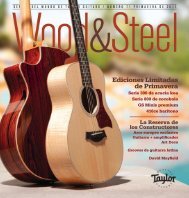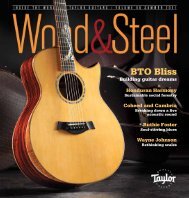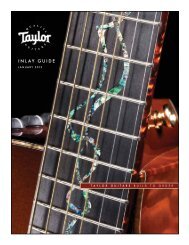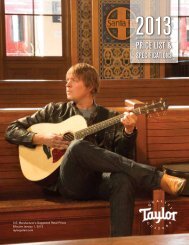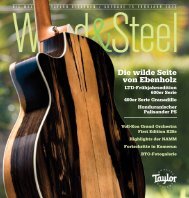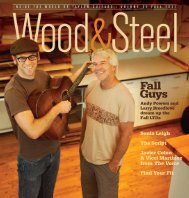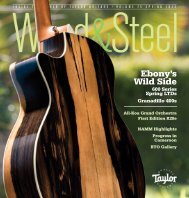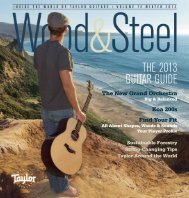You also want an ePaper? Increase the reach of your titles
YUMPU automatically turns print PDFs into web optimized ePapers that Google loves.
11<br />
Could the moisture emitted from<br />
a soundhole-covering humidifier,<br />
over time, damage the electronics<br />
of the ES or the exposed circuit<br />
boards that are part of many pickup<br />
amplification systems? Are the<br />
electronics coated to prevent rust?<br />
Paul Allen New<br />
Paul, only if you over-humidified your<br />
guitar. With the normal amount of<br />
humidity there will be no damage. That<br />
said, don’t use a soundhole-covering<br />
device. Let the humidifier condition the<br />
entire space inside the guitar case, as<br />
the whole guitar needs moisture, not<br />
just the interior of the body.<br />
Given the importance of the soundboard,<br />
is there any indication that<br />
pickguards on acoustic steelstrings<br />
adversely affect tone? I ask<br />
because I really love the look of<br />
your models without pickguards,<br />
and my style is almost exclusively<br />
fingerpicking.<br />
William Mays<br />
William, the pickguard is part of the<br />
package of the sound. A guitar that<br />
has a pickguard sounds like itself, and<br />
a guitar without a pickguard sounds<br />
like itself. We make a lot of guitars<br />
without pickguards, not so much for<br />
sound, but for looks. Either way, the<br />
guitars sound good. One could argue<br />
that a pickguard inhibits sound, and I<br />
won’t argue that point. You won’t have<br />
any problems with your guitar if it has<br />
no pickguard, so you should feel good<br />
about getting one.<br />
As I anxiously await the arrival<br />
of my custom GA thru the BTO<br />
program, I have a question<br />
regarding humidification. I’ve been<br />
using Dampits with my 810 and 714.<br />
Is tap water OK, or should I use<br />
distilled water?<br />
Brian V<br />
Burlington, NJ<br />
Tap water is just fine. No reason to<br />
make it more difficult to humidify your<br />
guitar.<br />
I have an all-koa, custom GS<br />
12-string that has a three-piece<br />
back with a flamed maple center<br />
wedge. It is gorgeous, of course,<br />
and the guitar sounds exceptional.<br />
I seem to remember reading once<br />
that three-piece backs mostly had<br />
to do with extending precious<br />
supplies of rare and expensive<br />
high-end tonewoods. Please help<br />
settle this.<br />
Ed Mehollin<br />
Ed, you’re right, a three-piece back is<br />
typically made to use narrower back<br />
panels and make them wide enough.<br />
With our mini wedge, it’s there only for<br />
cosmetic reasons, and often the wood<br />
used on a mini-wedged guitar was<br />
wide enough for a two-piece back. It’s<br />
all cosmetics, or use of wood, and has<br />
nothing to do with tone.<br />
3-piece<br />
back with<br />
mini-wedge<br />
I currently have three <strong>Taylor</strong>s: a<br />
<strong>Taylor</strong> T5-S, a <strong>Taylor</strong> 614ce that<br />
my wife bought me as a birthday<br />
present, and a wife with the last<br />
name <strong>Taylor</strong>. In “Ask Bob,” I have a<br />
keen interest in reading all about<br />
managing humidity on these guitars,<br />
as the winters in Canada are bone<br />
dry, and humidity levels can drop<br />
to below 35 percent. Most of the<br />
suggestions have been to keep the<br />
guitar in the case with all kinds of<br />
bits in the soundhole and neck, but<br />
I found that particularly frustrating<br />
when I wanted to play them, as I<br />
had to unpack them each time and<br />
repack when done. I found that my<br />
playing time dropped, and I played<br />
my ’52 Telecaster, as I don’t need to<br />
worry as much with it. So I wanted<br />
to share with you how I solved this<br />
issue.<br />
Recently we moved, and our new<br />
house had a large bookcase in the<br />
basement with three sections that<br />
had glass doors. I removed several<br />
shelves inside those cabinets and<br />
placed the guitars on stands. I then<br />
placed a large sponge in a container<br />
with some water and closed the<br />
doors. The hygrometer placed in the<br />
cabinet reports a consistent 50-53<br />
percent all day long. All I need to<br />
do is refresh some water in the<br />
sponge every couple of weeks to<br />
make this work. Now the guitars are<br />
not only easily accessible, but they<br />
are on display for all to see. I think<br />
that others can merely buy an IKEA<br />
cabinet and do the same.<br />
Jason McDermott<br />
Caledon, Ontario, Canada<br />
Jason, that’s a perfect solution. Make<br />
sure your hygrometer is digital. And<br />
put two of them in there. The needlebased,<br />
old-school hygrometers can<br />
literally glue themselves to some<br />
number like 50 percent and give<br />
you a false sense of security. Digital<br />
hygrometers work better, and two<br />
will always help, because if they read<br />
the same you probably have a good<br />
indication that they’re telling the truth.<br />
That’s all I’d add to your wonderful<br />
solution. You da man!<br />
I am a proud owner of a Big Baby<br />
and share it with my college-age<br />
daughter — we both love it! My<br />
latest love is with the ukulele. I had<br />
never seen a <strong>Taylor</strong> ukulele and was<br />
under the impression that no such<br />
beast was available. Well, I looked<br />
at the new Wood&Steel (2011 Guitar<br />
Guide) and to my delight I saw two<br />
ukuleles on the wall in the picture<br />
on page 60. Does <strong>Taylor</strong> make a<br />
ukulele, and if not, do you have<br />
plans to offer one in the future?<br />
Chris Palmer<br />
Northbrook, IL<br />
Lots of the guys at <strong>Taylor</strong> have been<br />
building ukes for themselves lately,<br />
either from kits or from scratch. We<br />
do have plans for a ukulele. I can’t say<br />
when, because it’s unclear, but we will<br />
do it.<br />
Is there a difference between<br />
Indian rosewood and East Indian<br />
rosewood? I’ve noticed that some<br />
guitar makers specify that they<br />
use East Indian rosewood on their<br />
guitars, and I’ve always wondered<br />
if there is a recognized, qualitative<br />
difference between the two, or if this<br />
is just an alternative designation for<br />
the same wood.<br />
Moyer Hubbard<br />
They are the same, just different ways<br />
of saying it.<br />
I currently own a 614. I love the<br />
bright, crisp sound, but it is a little<br />
short on the bass. What products in<br />
the <strong>Taylor</strong> line will keep the bright<br />
sound of maple and provide more<br />
on the low end? I’m not interested in<br />
pushing the bottom end to the point<br />
that the guitar sounds “boomy.”<br />
Douglas Hudgens<br />
That’s simple. A 616ce. The larger<br />
body will give you more bass. The<br />
maple and the <strong>Taylor</strong> design will give<br />
you the bright sound you like.<br />
616ce<br />
I own eight <strong>Taylor</strong> guitars and love<br />
them all! It will be nine as soon<br />
as I can get my hands on a GS<br />
Mini. They each have their unique<br />
voice, from the DN to the GS. I’m<br />
primarily a fingerstyle player with<br />
a classical background and enjoy<br />
learning the blues as played by<br />
the original artists. This brings me<br />
to wanting to design a BTO blues<br />
guitar with an old-fashioned, soulful<br />
voice. I’m thinking a 12-fret with<br />
an Adirondack spruce top (tobacco<br />
sunburst, of course), mahogany<br />
back and sides, mahogany neck<br />
with ebony headstock overlay, and<br />
cream binding and purfling. I think<br />
this would deliver the instrument I’m<br />
looking for. However, I would like<br />
the neck to be as wide as possible<br />
at the nut, 1-7/8 or more. Your<br />
thoughts?<br />
Tom Rusiecki<br />
Port Richey, FL<br />
Tom, the neck width isn’t a problem.<br />
If this were mine, I’d consider a<br />
mahogany top. Just consider it. Don’t<br />
let me talk you into anything, but<br />
compared to a spruce top it will have a<br />
darker sound and would sing the blues<br />
a little mo’ betta.<br />
Mahogany top<br />
Got a<br />
question for<br />
Bob <strong>Taylor</strong>?<br />
Shoot him an e-mail:<br />
askbob@taylorguitars.com.<br />
If you have a specific<br />
repair or service<br />
concern, please call<br />
our Customer Service<br />
department at<br />
(800) 943-6782,<br />
and we’ll take<br />
care of you.




